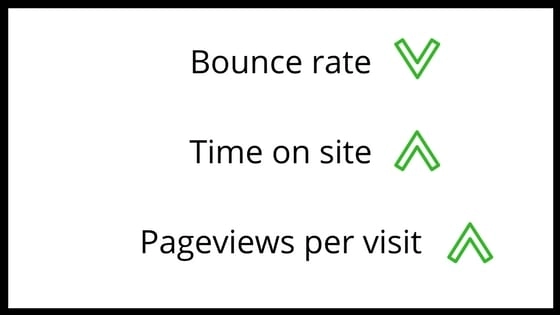3 User Experience Metrics That Are Correlated With SEO

User Experience Metrics That Are Correlated With SEO

The 3 User Experience Metrics

So tell me something I don’t know, Tyler
Well, I’ll tell you something that you probably might know (or suspect) first, then I’ll share with you what opportunity I think most people are missing. Even if you know these metrics and look at them, do you know how to affect them, and do you know just how impactful improving them can be?
The correlation between SEO and user experience
I’m going to save you the history lessons and discussions surrounding why user experience is important to search engines, like Google, and just assume you understand the basics of modern SEO. If you don’t, I would recommend checking out this post on [SEO auditing your own site](https://blog.ezoic.com/seo-audit-website/).

figure A
As you can see above (figure A), these three user experience metrics were all improved over the course of the time period above. There were likely other changes during this time set; however, it is important to recognize the correlation this site had with improved UX metrics and increased organic search traffic. See how both are positively associated.

figure B

figure C
In figure B and C, we can see another site that was able to optimize ad combinations and layouts to improve their bounce rate and pageviews per visit during a 3 month time period.

figure D

Too focused on the result, not the process

- Content positioning/organization
- Image density
- Website Layout
- Menu location
- Color scheme
- Location of other navigational elements
- Ads
- Density
- Location
- Type
- [Page speed](/?p=17036)
- Internal linking architecture
There are obviously more; however, those are some of the most common ones that digital publishers and website owners can manipulate.
Optimizing for user experience

Testing is your friend
Once you’re looking at these user experience metrics the same way you look at keyword changes and the like, you’re ready for step 2. Testing.
Testing is by far the most complex and **the most important part of improving user experience metrics**. The reason why it’s difficult is because every user is different — and that means different from you and me — so making changes based on preference is a very slow process.
A/B testing is traditionally too slow. [Multivariate testing](https://blog.ezoic.com/what-is-multivariate-ad-testing-and-how-does-it-work/) is a way you can effectively get going in the right direction a lot faster. But what do you test?
Remember our list from above…
- Test content structure
- Test menu locations (especially on mobile)
- Test different themes or layouts
- Test ad placements
- Test how different scripts on your site may be affecting UX

There are no user experience winners and losers

Improve user experience, get more visitors
It sounds simple, but I know it’s not easy. The biggest and most important thing to remember is that you have to start with the end in mind. If you want to improve user experience metrics for the large search traffic benefits, you have to start looking and optimizing those metrics above some of the traditional things you might currently be looking at.
I recommend testing as a starting point. There are a lot of ways to do this, and obviously, I believe Ezoic is a great place to start if you’re a digital publisher or website owner.
If you have additional questions about the data above, SEO, or this strategy leave them below. I answer back with 12 hours.

